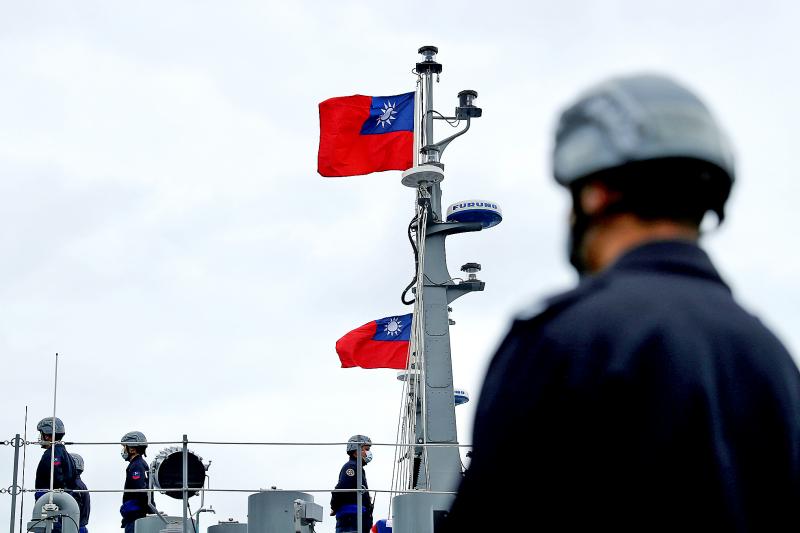The Chinese military would be capable of fighting against Taiwan and allied forces by 2027, a Ministry of National Defense (MND) report said yesterday.
China has set a goal of modernizing its warfare capabilities by that year, which is to mark the 100th anniversary of its army’s founding, and it might by then be able to act more aggressively toward Taiwan, said the report, which the ministry submitted to the Legislative Yuan for review.
The ministry did not cite any evidence that China was planning to invade Taiwan by 2027 or provide any intelligence that Beijing had given up on its vow to achieve “peaceful unification.”

Photo: Ritchie B. Tongo, EPA-EFE
China has over the past few years stationed an increasing number of warships along its southeastern coast, as it is seeking to maintain its military advantage in the region and attempting to build a system of intelligence warfare by 2027, the report said.
By 2027, China is expected to possess regional air defense capabilities, and long-range sea and airstrike systems, which would greatly extend its combat range, following the introduction of its aircraft carriers Liaoning and Shandong, a second-generation Type 003 vessel, as well as the mass production of Type 055 destroyers, Y-20 tanker aircraft and J-20 fighters, the report said.
The ministry said Chinese naval and air forces would be capable of projecting power at greater distances from its territory, extending its reach of military operations and enabling it to counter joint forces between Taiwan and its allies.
Taiwan would respond by improving its defense capabilities in joint operations against an invasion through integrated air defense systems and maritime interception, the report said.
The ministry said it would also focus on armed forces development, including plans for mass production of mature weapons, but did not specify a kind of weapon.
The report said that China is continuing to develop its capabilities to counter the US military in the Indo-Pacific region, which remains an integral part of Washington’s strategic focus, despite Russia’s invasion of Ukraine.
The ministry said there could be an intensified US-China standoff in the region by 2027 over issues including cross-strait relations, tensions on the Korean Peninsula and territorial disputes in the South China Sea, which could increase the risk of conflict between the two countries.
Minister of National Defense Chiu Kuo-cheng (邱國正) last year said that China would be capable of launching a full-scale invasion of Taiwan by 2025, but he did not elaborate on whether it would be able to deal with US involvement in such a war.
Chairman of the US Joint Chiefs of Staff General Mark Milley has since last year reiterated that China aims to develop the capability to invade Taiwan by 2027.
However, he last year also said that although China might want to develop that capability, he sees no near-term intent to do so.

ROLLER-COASTER RIDE: More than five earthquakes ranging from magnitude 4.4 to 5.5 on the Richter scale shook eastern Taiwan in rapid succession yesterday afternoon Back-to-back weather fronts are forecast to hit Taiwan this week, resulting in rain across the nation in the coming days, the Central Weather Administration said yesterday, as it also warned residents in mountainous regions to be wary of landslides and rockfalls. As the first front approached, sporadic rainfall began in central and northern parts of Taiwan yesterday, the agency said, adding that rain is forecast to intensify in those regions today, while brief showers would also affect other parts of the nation. A second weather system is forecast to arrive on Thursday, bringing additional rain to the whole nation until Sunday, it

LANDSLIDES POSSIBLE: The agency advised the public to avoid visiting mountainous regions due to more expected aftershocks and rainfall from a series of weather fronts A series of earthquakes over the past few days were likely aftershocks of the April 3 earthquake in Hualien County, with further aftershocks to be expected for up to a year, the Central Weather Administration (CWA) said yesterday. Based on the nation’s experience after the quake on Sept. 21, 1999, more aftershocks are possible over the next six months to a year, the agency said. A total of 103 earthquakes of magnitude 4 on the local magnitude scale or higher hit Hualien County from 5:08pm on Monday to 10:27am yesterday, with 27 of them exceeding magnitude 5. They included two, of magnitude

CONDITIONAL: The PRC imposes secret requirements that the funding it provides cannot be spent in states with diplomatic relations with Taiwan, Emma Reilly said China has been bribing UN officials to obtain “special benefits” and to block funding from countries that have diplomatic ties with Taiwan, a former UN employee told the British House of Commons on Tuesday. At a House of Commons Foreign Affairs Committee hearing into “international relations within the multilateral system,” former Office of the UN High Commissioner for Human Rights (OHCHR) employee Emma Reilly said in a written statement that “Beijing paid bribes to the two successive Presidents of the [UN] General Assembly” during the two-year negotiation of the Sustainable Development Goals. Another way China exercises influence within the UN Secretariat is

Taiwan’s first drag queen to compete on the internationally acclaimed RuPaul’s Drag Race, Nymphia Wind (妮妃雅), was on Friday crowned the “Next Drag Superstar.” Dressed in a sparkling banana dress, Nymphia Wind swept onto the stage for the final, and stole the show. “Taiwan this is for you,” she said right after show host RuPaul announced her as the winner. “To those who feel like they don’t belong, just remember to live fearlessly and to live their truth,” she said on stage. One of the frontrunners for the past 15 episodes, the 28-year-old breezed through to the final after weeks of showcasing her unique